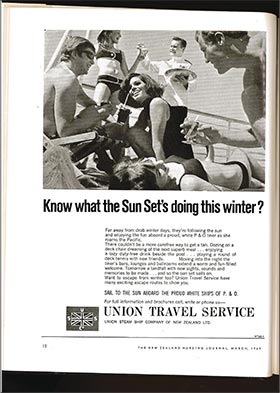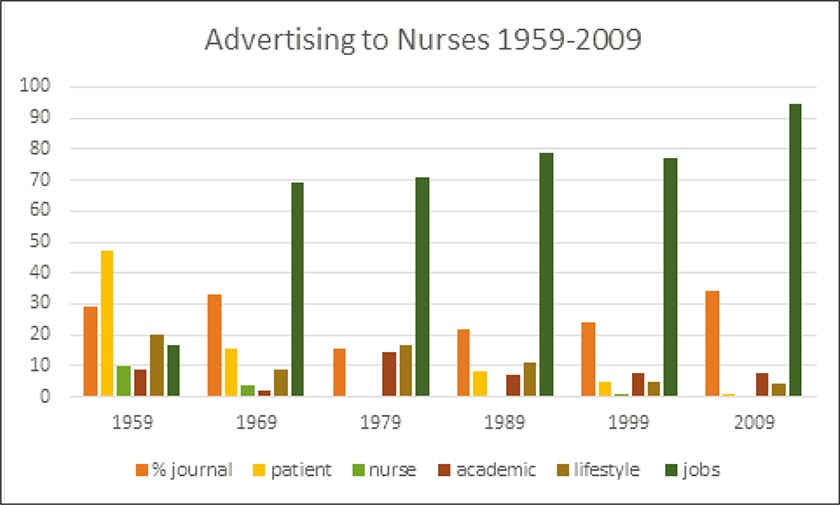
The second part of this article examines advertising to nurses in Kai Tiaki from 1959 to 2009. Part one of the analysis – Advertising in Kai Tiaki down through the decades – explored the first 50 years of the journal from 1908-1958 through a social constructionist lens. Through this lens, it was apparent there were two themes of how nurses were portrayed in that date range: the nurse as a wellbeing advocate (1908-1928), and the nurse as servant of the state (1929-1958).
The full methodology was described in part one, where advertising to nurses was categorised initially under four headings: patient benefits, nurse benefits, academic activities and lifestyle items.
For this second part of the analysis, job advertisements have been included. As with part one, these different areas will be analysed alongside key social events of the day. This part of the analysis was limited to the final year of each decade (1959, 1969, 1979, 1989, 1999, and 2009), due to the larger number of journals printed each year (up to 12) and the similarity of content across each decade.
A total of 72 issues were individually analysed. A further randomly selected 20 issues after 1959 were checked to ensure there were no major changes which may have been missed by limiting the analysis to one year of each decade. All journals reviewed appeared complete and were examined in print form.
As with the earlier analysis, each selected issue was analysed for the percentage of pages devoted to advertising; any special features of a particular issue; and the number of individual adverts under each classification.
Results
By the 1950s, the journal had undergone significant changes in both style, print, the use of colour and content. By 1959, placement of advertising included inside front and back covers and the journal was a larger format. Each issue also included significantly more job advertising than the previous 50 years, reaching almost two thirds of the total adverts by 1969. This was clearly at the cost of patient and nurse adverts, which had all but disappeared by 1979. By 2009, most of the adverts were now for jobs.
Nursing as a lifestyle (1950s and 1960s)
The 1950s was a prosperous time for the country, with the population reaching two million. The baby boom was underway, with almost 400,000 births. New Zealanders had fought in the Korean War and Mt Everest had been conquered by Edmund Hillary, (later Sir Edmund Hillary). The first “supermarket” (Foodtown) opened in 1958 in South Auckland.1

In the July 1969 issue, there was an advert targeting overweight nurses, promoting weight loss supplements, presumably to fit into the bikinis portrayed in the holiday adverts. It was also possible to hire a television for those leisure hours once television broadcasting began in June 1961.2
Technology related to patient care was on the increase, with adverts for disposable bedpans and the use of computer technology to manage patient information was reported in the March 1969 issue. In September of 1969, the profession changed forever with the registration of the first male nurses. Initially, while male nurses did not feature in any advertising, a male nurse was featured on the cover of the November 1969 issue.
The glossy look and feel of the journal, combined with the increased lifestyle and job adverts of the 1950s and 1960s, suggested nursing was a desirable career with many options both in New Zealand and overseas (mainly Australia and the United Kingdom).
Nurses as political beings (1970-1980s)
The journals produced through the 1970s were vastly different to the previous almost glamorous publications of the 1950s-1960s. A new editor had a vision that the journal was all about the professionalisation of nurses and for the members of the union. The almost frivolous looking journals of the preceding two decades were replaced with a dry style of writing and most of the journals were devoted to meeting notes, political remits and the like. The back pages had gone from being a place to put key lifestyle adverts for nurses, to a place to put lists of union meetings.
Professionally, nursing was coming of age, with the start of the first comprehensive training programmes based in polytechnics (now tertiary education institutes) not hospitals, in the early ’70s. This huge change in the education of nurses followed on from the Carpenter Report published in 1971, cited in a review of nurse education.3
Politically, nursing also had a voice with the beginning of nurse-led protests for better conditions reported on in September 1979.
Cross-cultural care was discussed, including how to apply this within a Samoan context in a New Zealand hospital.4 By the end of the ’70s, the population of Pacific people in New Zealand was around four per cent.5
Academic and lifestyle advertising remained constant with previous decades; however, by 1979 there was no advertising of things to improve patient outcomes and nothing to enhance clinical practice. It was all about jobs (71 per cent) and unionism.
One bright note was evident in that New Zealand nurses could now work in the United States, with Las Vegas being promoted as a possible working destination.
By 1989, the tone and feel of the journal had softened slightly and included some of the hefty health-care issues affecting the country. Protests continued for better pay and conditions, with strikes occurring. There were concerted efforts to unite the two nursing unions to ensure a stronger political voice.
The Cartwright Report (1988) had been published. The report was of a commission of inquiry into how women with cervical cancer had been treated at National Women’s Hospital, which had been the subject of a book, The Unfortunate Experiment. The Cartwright Report changed the way informed consent was obtained for all patient care.6
AIDS was now rearing its head in New Zealand and universal precautions for infection control were introduced against a backdrop of severe health cuts. New Zealand had its first recorded death of a patient due to AIDS in 1983;7 however records of such deaths didn’t begin until 1985.8 The Homosexual Law Reform Bill was passed in 1986. It allowed for consensual homosexual sex over the age of 16.9
By the end of the 1980s, if a nurse wanted to get away from the poorly funded, overworked New Zealand health-care system, then working in Saudi Arabia and the United States were lucrative options, with adverts offering paid flights and accommodation. Job advertising was now almost 80 per cent of the advertising.
The occasional advert for patient-centred items, mainly related to wound care, reappeared. As in the 1970s, there was no advertising of items specifically for the benefit of nurses in their working day. It was either jobs (79 per cent), leisure (10.8 per cent) or a smattering of education (7.37 per cent) or patient benefits (8.06 per cent). Some issues did not contain any advertising apart from jobs. As an example of consumer spending expectations, an entry-level new car was advertised in September 1989 for $16,000, which seems excessive given the salary range of registered nurses was $12-$16,000.
Nurses as independent beings (1990s-2009)
Analysis of the final 20 years in the 100-year review showed nurses having many career options. They were often pictured working in civilian clothing, providing care or advice. By 2006, 50 per cent of nurses worked in hospital settings, compared to 80 per cent in 1986. By 2008, the average age of registered nurses had increased to over 45 for more than half of the workforce.10
The comprehensive education model was now well established, and had undergone a review, with nurses now being trained to degree level and a number of universities offering nursing degrees, along with polytechnics/institutes of education.
The most pressing issue at the end of the millennium was the potential impact of the “Y2k bug”, which had the potential to disrupt all services. For example, Gisborne Hospital was preparing for a potential onslaught of people travelling there to see in the new millennium by committing suicide.11
By 2009, job advertising constituted the vast bulk of adverts at 94 per cent, with all advertising taking up more than 30 per cent of the journal.
By 2009, while the focus of the journal was still as a union voice for its members, there were adverts for nurses departing for brighter climates, eg the emergence of locum work in Australia.
It was also evident at this time that New Zealand had a significant immigrant nursing population who had different issues to locally-trained nurses. This was also mentioned in the report that noted that since 2004, internationally-qualified nurses (IQNs) outnumbered New Zealand new graduate nurses.12 In various issues in 2009 there were adverts and articles targeting IQNs, such as how to send money home and how to adapt to a New Zealand way of life. One article looked at ways to recruit and support these nurses in New Zealand.12
Conclusion
This analysis of advertising to nurses in New Zealand over 100 years covered the inception of Kai Tiaki in 1908, through its various iterations until 2009. By using a social constructionist lens, advertising has been placed in the context of the social events of the time. Through this approach, it is possible to see how the perception of nurses as consumers has changed over time. There was huge growth in job advertising after World War II (WWII), reaching almost 100 per cent of the journal’s advertising content by 2009. This growth corresponded with a decline in adverts targeting patient benefits, which peaked in the pre-WWII period at more than 70 per cent of advertising space, gradually declining to virtually nil by the 1990s.

Lifestyle advertising was fairly consistent across the decades, with a peak of just over 20 per cent in the 1958 decade, which paralleled the high economic growth New Zealand was experiencing at the time.
Advertising of items for the benefit of the nurse were reasonably prominent in the early decades, but by 1979 they had disappeared altogether.
Advertisers clearly see nurses as a worthy advertising audience, given the space devoted to advertising over the 100 years.
This analysis has shown that, as nursing has evolved over the century, so too has the type of advertising. Every issue analysed had some advertising, even during the bleakest economic times. The total space allocated to advertising ranged from the lowest at less than 10 per cent in 1915 to the highest at more than 34 per cent in 2009.
Acknowledgement: I am grateful for the voluntary assistance provided by history graduate Nyle Maddocks-Hubbard, who helped with the collection and cross-checking of data in both electronic and print format.
Wendy Maddocks, RN, DHlthSc, BA, MA, is a lecturer in the School of Health Sciences at the University of Canterbury.
References
- New Zealand History. (n.d). The 1950s.
- New Zealand History. (n.d). New Zealand’s first official TV broadcast.
- Department of Health. (1988). Nursing Education in Transition: the transfer of nursing education to the general system of education 1973-1988: the Department of Health’s perspective (PDF, 2.1MB).
- Kinloch P. (1979). Cross-cultural communication in New Zealand: Samoans and nurses in action. The New Zealand Nursing Journal Kai Tiaki, 72(4), 19-22.
- New Zealand History. (n.d). The 1980s.
- Cartwright, S. (1988). The Report of the Cervical Cancer Inquiry.
- Anonymous. (n.d). HIV/AIDs in New Zealand.
- Ministry of Health. (n.d). HIV/AIDS.
- New Zealand History. (n.d). Homosexual Law Reform Bill passed 9 July 1986.
- Cook, L. (2009). A Nurse Education and Training Board for New Zealand, Report to the Minister of Health: An evaluation of the need for a Nurse Education and Training Board for the oversight of nursing education and training in New Zealand (PDF, 410KB).
- Eye Witness. (2018). Are you Y2K OK?
- Wright, K. (2009). Supporting international nurses in their practice: New Zealand’s heavy reliance on overseas nurses. Kai Tiaki: Nursing New Zealand, 15(7), 24.


